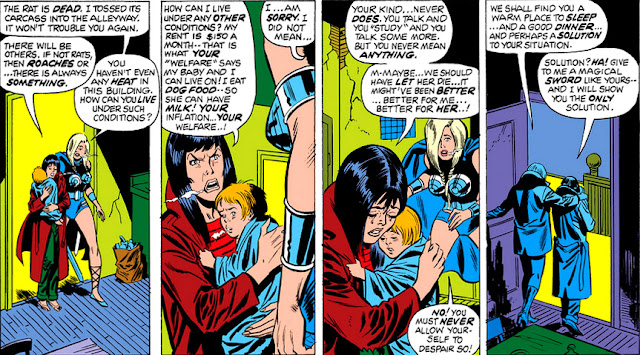"As the first serpent drove Adam and Eve from Eden, so shall we drive from this land the unfit, the foreign-born, the inferior."
At first glance, the credo of
the Sons of the Serpent might seem counter-productive to their goal of purging non-white, non-indigenous persons and ethnic groups from America; after all, even people of like mind might think twice about siding with an organization which appears to take pride in the means by which two white people were driven from paradise forever. But the group we're talking about has little to do with logic, or reason--or, it perhaps goes without saying, humanity.

Looking back at the appearances of the Sons of the Serpent and those who have opposed them, it might be difficult to see even a clearly racist organization such as themselves drawing the involvement of a super-team such as the Avengers, who have gone up against them twice; were it not for the fact that the Sons adopted flamboyant, menacing costumes and had a S.H.I.E.L.D. dossier, they might have been a group better suited to the F.B.I. to investigate and build a case against. And if the involvement of costumed heroes somehow
were warranted, individuals such as Daredevil and/or the Black Panther could be dealt in to make for an intriguing and perhaps even more gripping story than a cry of "Avengers Assemble!" might provide.
That said, it's been surprising how writers Stan Lee and Roy Thomas were able to craft
Avengers tales which directly involved the Sons and spanned more than one issue. Both stories were a means to an end, in that each came down to a figurehead that could be unveiled and toppled and thus be quickly and neatly wrapped up--though frankly the Sons' cause wasn't helped by adopting a snake motif and having their organization fronted by their spokesperson, the "Serpent Supreme," thus conveying the impression that it was
his agenda that he sought support for rather than pushing a message to reflect that the Sons as a whole were tapping into the pulse of all Americans. Instead, the Sons crafted a deception
within a deception, which could only make their organization appear even more insidious.
Yet would the Avengers have been as effective against an organization that wasn't so blatant in its operations? We've seen how the team became
split right down the middle when it came to choosing between tracking down the movements of the criminal cartel, Zodiac, vs. helping a Native American seeking justice against a white, ruthless businessman trying to force his people to vacate their lands. Would the team have even turned their attention to the Sons if that group's activities didn't involve one of their own, as was the case in each of their dealings with that group as well as with
Red Wolf? With the exception of giving assistance to the Panther... er, the
Leopard following his disappearance in Rudyarda, a white supremacist stronghold, the Fantastic Four's adventures seldom pivoted to stories on race--preferring to make their statement on the subject by analogy (e.g., the
Monster of the Lost Lagoon, the Mole Man,
Omega, et al.)--the X-Men taking a similar tack with their focus on the persecution of and bigotry against mutants.
You would think, then, that the non-team known as the Defenders would have even
less reason to cross paths with the Sons, since the amount of interaction and exposure involved would represent a sharp turn toward the very things they seek to avoid: television cameras... news coverage... large crowds... to say nothing of the paper trail of culpability leading back to one Defender in particular (though we'll get to that in due time). Yet writer Steve Gerber manages to craft a well-structured and at times riveting
four-part story
* which makes folding the Defenders into the Sons' race war believable--all the more so since it will lead to the involvement of not just one but two of their members on a personal level.
*It seemed negligent not to emphasize that; one can grow very fatigued with that much Sons of the Serpent exposure if the material isn't handled carefully.
The first of those we come to immediately--the Valkyrie, who responds to a terrified cry and is witness to a sight more horrific than any she has beheld in the company of her comrades.













































